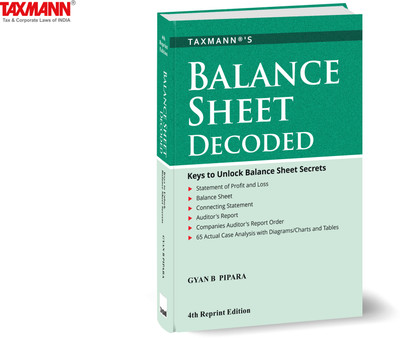Taxmann's Balance Sheet Decoded ŌĆō Systematic Approach to Analysing Financial Statements by Connecting Details | Observations | DiscussionsŌĆöExtensive Usage of Charts | Case Analysis | Other Tools(Hardcover, Gyan B Pipara)
Quick Overview
Product Price Comparison
This book aims to explain how to read, analyse, and interlink the voluminous information available in financial statements using charts, case analysis, and other tools. It provides an in-depth, step-by-step approach to understanding and decoding financial statements. The book is structured around five keys, each focusing on different components of financial statements. (i) Key #1 ŌĆō Statement of Profit & Loss (a) Covers Sales, Other Income, Cost of Materials Consumed, Manufacturing and Operating Costs, Fi-nance Costs, Depreciation and Amortisation, Tax Expenses, Other Expenses, and Exceptional Items (ii) Key #2 ŌĆō Balance Sheet (a) Details Tangible and Intangible Fixed Assets, Investments, Loans & Advanc-es, Other Assets, Inventories, Trade Receivables, Cash and Bank Balances, Shareholder's Funds, Provi-sions, Contingent Liabilities, Borrowings, Trade Payables, and Other Liabilities (iii) Key #3 ŌĆō Connecting Statements (a) Examines Significant Accounting Policies, Notes on Accounts, and Cash Flow Statements (iv) Key #4 ŌĆō Auditor's Report and CARO (a) Discusses the Concept of Audit, Internal Financial Controls, Auditor's Opinion, Emphasis of Matters, and the Companies Auditor's Report Order (CARO) (v) Key #5 ŌĆō Master Key (a) Integrates the Profit & Loss Statement, Balance Sheet, Notes on Accounts, Auditor's Report, and CARO Report for comprehensive financial statement analysis This book extensively deals with the following issues & suggests how they can be mitigated through proper analysis of financial statements: (i) Mounting Bad Loans ŌĆō Analyses the alarming rise in non-performing assets (NPAs) in Indian public sector banks and the impact of stress tests conducted by the Reserve Bank of India (RBI) (ii) Bank Frauds ŌĆō Explores the root causes of bank frauds and provides strategies to mitigate these risks (iii) Liquidity Crunch ŌĆō Discusses the liquidity issues faced by various financial sectors and their ef-fects on investment returns (iv) Regulatory Insights ŌĆō Guides regulators on using financial statements to ensure compliance and assess financial health This book will be helpful to anyone analysing based on financial statements, including but not limited to: (i) Bankers ŌĆō Enhance skills in loan appraisal and mon-itoring through detailed financial statement analysis (ii) CFOs ŌĆō Understand the balance between busi-ness transactions and necessary disclosures (iii) Auditors ŌĆō Identify and counteract accounting tricks to ensure fair financial reporting (iv) Analysts and Researchers ŌĆō Conduct thorough financial statement studies to detect misleading practices (v) Investors and Stakeholders ŌĆō Evaluate the genuineness of fi-nancial data for informed investment decisions (vi) Regulators ŌĆō Use financial information for regulato-ry assessments and ensure compliance The Present Publication is the 4th Reprint Edition authored by Gyan B. Pipara, with the following noteworthy features: (i) [Reading Between the Lines of Financial Statements] Correlating relevant information using the author's 40+ years of experience with proper analysis. (ii) [Honing Analytical Skills] Provides methods to dissect financial statements with precision. (iii) [Unlocking Mysteries & Tricks] Explains how to analyse details and detect undisclosed information. (iv) [Focused Analysis] Helps identify strengths, early warning signs, frauds, creative accounting, and the genuineness of various items. (v) [Professional Oriented Book] This book has been developed keep-ing in mind the following factors: (a) Interaction of the author during his training with various banks and organisations on credit and analysis of the financial statement (b) Shaped by the authors' experi-ence of 40+ years being a chartered accountant, research analyst and fraud investigator (c) Reactions and responses of attendees during the training have also been incorporated at different places in the book (vi) [New Chapter on CARO 2020] has been considered in detail under Key #4 ŌĆō The Companies Auditor's Report Order.

